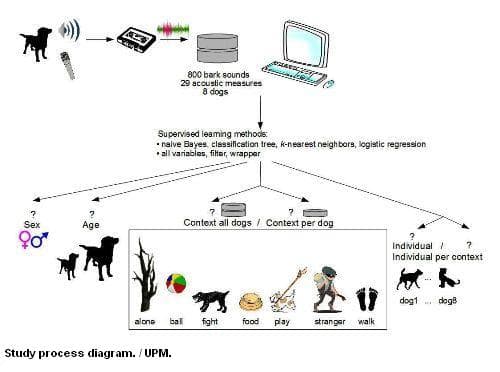Computer algorithm can identify your dog, its gender and age from its bark
Computer algorithms can now analyse the important information hidden in dog's bark. Researchers from <a href="https://www.upm.es/internacional" target="_blank" rel="noopener noreferrer">Internacional</a> (UPM) along with students from #-Link-Snipped-# and the Department of Ethology from #-Link-Snipped-# of Budapest have developed special algorithms that can accurately determine the age, gender, context and even identify the dog itself by listening to its bark. The findings of the research could help various organisations to identify the dog state and carry out relevant tasks.
The research on canine communication has largely focused on studying how the dogs can interpret various forms of human communication - for example by displaying various gestures and identifying unique human voices. The research carried out by UPM focused on processing the acoustic information hidden in dog's bark when the dogs were subjected to various situations. The research focused on analysis and development of computing algorithms that allowed the researchers to uniquely identify the dog and also figure out its gender and age very accurately.

Guess My Age?
The experiment was performed on three male and five female dogs belonging to different breeds. The dogs were subjected to various conditions like the dog tied to the tree, playing with a ball, fighting, receiving food, in company of an unknown dog etc. Each of the 800 barks from various situations was analysed for about 29 acoustic different acoustic parameters.
These parameters were fed to the computers to determine the gender of the dog with 85.13% success rate, age with ~80% success rate and the situation the dog was in; with a success rate of about ~55%.

Image Credit: UPM
Researchers believe that the study enables new possibilities in canine research through exploration of information in dog's barking. Computational algorithms developed for analysis of dog's behavior from its bark can be helpful for several organisations. Read more about the research on the official UPM website linked in the source below.
Source: #-Link-Snipped-#
The research on canine communication has largely focused on studying how the dogs can interpret various forms of human communication - for example by displaying various gestures and identifying unique human voices. The research carried out by UPM focused on processing the acoustic information hidden in dog's bark when the dogs were subjected to various situations. The research focused on analysis and development of computing algorithms that allowed the researchers to uniquely identify the dog and also figure out its gender and age very accurately.

Guess My Age?
The experiment was performed on three male and five female dogs belonging to different breeds. The dogs were subjected to various conditions like the dog tied to the tree, playing with a ball, fighting, receiving food, in company of an unknown dog etc. Each of the 800 barks from various situations was analysed for about 29 acoustic different acoustic parameters.
These parameters were fed to the computers to determine the gender of the dog with 85.13% success rate, age with ~80% success rate and the situation the dog was in; with a success rate of about ~55%.

Image Credit: UPM
Researchers believe that the study enables new possibilities in canine research through exploration of information in dog's barking. Computational algorithms developed for analysis of dog's behavior from its bark can be helpful for several organisations. Read more about the research on the official UPM website linked in the source below.
Source: #-Link-Snipped-#
0
